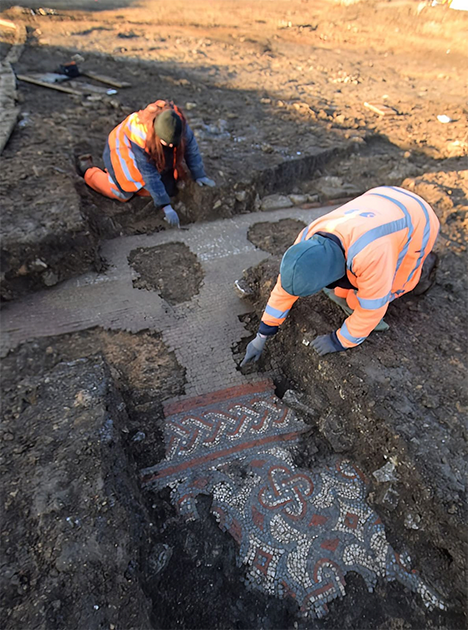Archaeologists in England have announced the remains of an ancient Roman villa and bath house buried beneath what will become a new supermarket.
The rare mosaic brickwork was discovered in Warrington Road in Olney, Buckinghamshire, near the town of Milton Keynes. The dig was conducted by Oxford Archaeology, who carried out the work for developer Angle Property at a site being prepared for the construction of a new Aldi supermarket.
And so special is this ancient artwork that the discovery team not only described as “intricate,” but they said it’s “archaeological remains of high significance.”
Unlayering of Ancient Olney
Olney is a town located in Buckinghamshire, England, and it boasts a rich history dating back to the Roman occupation of Britain. The town played an important role in the wool trade during the Middle Ages and is perhaps best known for its connection to the 18th century poet and hymn writer, ‘William Cowper,‘ who wrote “The Task” and the hymn “God Moves in a Mysterious Way.”
Previous excavations carried out around the town have unearthed Roman settlements and medieval buildings, but one of the most famous discoveries made in Olney was the remains of a Roman villa , which was unearthed in the early 20th century. Dated to around AD 150, the villa was home to a wealthy Roman family who basked in a lush bath house and underfloor heating system. Many medieval timber-framed buildings still standing today including St Peter and St Paul’s churches, dating back to the 14th century.

As is often the case, what remains of the mosaic at Olney is in great condition. ( Oxford Archaeology )
What Lies Beneath
According to Historic England the dig was commissioned due to the site’s proximity to the aforementioned Roman site at Olney. Made up of red, white and blue tiles the team of archaeologists said the mosaic featured “vibrant colors and intricate decorative patterns.”
John Boothroyd, senior project manager at Oxford Archaeology, said that due to the site location they anticipated some notable Roman remains, but the discovery of this fantastic mosaic “far exceeded those expectations.” Furthermore, the team believes many more parts of the ancient artwork remain hidden under Warrington Road, but because of their location they won’t be excavated.
Lost Roman Arts In England
Roman mosaics were a popular form of decorative art across the ancient Roman empire. They were used to decorate floors, walls, and ceilings of public buildings, private homes, and places of worship.
They were made by piecing together small, colored stones, glass, or ceramic tiles, known as tesserae, into intricate designs and patterns. Often depicting scenes from mythology and historical events, Roman mosaics were highly valued for their beauty, durability, and the skill required to create them.
Anthony Williamson, executive director of Angle, said the find had “taken us all by surprise.” And he added that to be able to preserve remains of this “quality and importance” is a brilliant outcome, promising that it “will be fully recorded” and information about it published in the near future. Oxford Archaeology said following consultations with Historic England and Milton Keynes Council the mosaic was covered up and preserved in situ. This means construction of the new Aldi supermarket can proceed without causing damage to the rare ancient artwork.
Mosaics Across Britannia
It is not easy to put an exact number on the Roman mosaics discovered in England, as any discovered in the 19th century have now been lost. However, many can be seen in museums, churches, and at exhibits at archaeological sites.
Some of the most famous examples can be found at the Roman villas of Fishbourne and Chedworth, at the Roman Baths in Bath, the Lullingstone Roman Villa in Kent, and the Bignor Roman Villa in West Sussex.
The biggest Roman mosaic in England, however, was discovered in 1960 at the 3rd century Roman villa of Durnovaria (modern-day Dorchester), in the county of Dorset. This mosaic measures approximately 11 meters square and is composed of over 4 million tesserae featuring intricate geometric patterns and images of sea creatures, birds, and other animals. Today, the mosaic is on display at the Dorset County Museum in Dorchester, where visitors can marvel at its size and beauty.
Top image: Remains of the Roman mosaic discovered at Olney, England. Source: Oxford Archaeology
By Ashley Cowie
 RSS Feed
RSS Feed













 March 18th, 2023
March 18th, 2023  Awake Goy
Awake Goy  Posted in
Posted in  Tags:
Tags: 
















